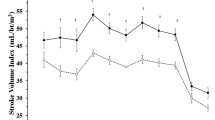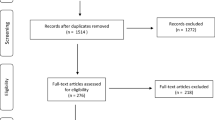Abstract
The effect of 14-day head-up bedrest (HUBR) on human orthostatic tolerance was studied with participation of 23 apparently healthy male subjects aged 18 to 35 years. HUBR with the head tilted up at +9.6° was to simulate the physiological effects of lunar gravity. Orthostatic tolerance was tested on the day prior to and immediately after HUBR completion with subjects tilted up to +70° for a maximum of 20 min. The parameters recorded before, during, and after the tilt test included blood pressure, ECG, and heart rate, the health status of the subjects was also monitored. In comparison with the baseline testing, HUBR reduced the number of completed tests and increased the number (10 vs. 4) of tests terminated due to precollapse (p < 0.05). The group mean time of orthostatic test (OT) tolerance decreased by 3.8 min (p < 0.01), and the time interval between the test onset and precollapse decreased by 4.7 min (p = 0.055). In most cases, orthostatic disorders following HUBR were described as a hypotensive (vasodepressor) type of tilt-induced collapse with high activity of the chronotropic function of the heart. Several cases of vagus-mediated heart rate deceleration indicated a sharp decline of the sympathetic nervous activity, which is an important mechanism for regulating hemodynamics under altered postural conditions.




Similar content being viewed by others
REFERENCES
Smith, M., Craig, D., and Herrmann, N., et al., The Artemis program: an overview of NASA’s activities to return humans to the Moon, Proceedings of the 2020 IEEE Aerospace Conference, Big Sky, MT, USA, 7–14 March, 2020, p. 1.
Federal Space Program of Russia for 2016–2025, approved by the Decree of the Government of the Russian Federation, no. 230, March 23, 2016.
Baranov, V.M., Katuntsev, V.P., Baranov, M.V., et al., Challenges to space medicine in human exploration of the Moon: risks, adaptation, health, performance, Ulyanovsk. Med.-Biol. Zh., 2018, no. 3, p. 109.
Richter, C., Braunstein, B., Winnard, A., et al., Human bio-mechanical and cardiopulmonary responses to partial gravity—a systematic review, Front. Physiol., 2017, vol. 8, p. 583.
Meck, J.V., Reyes, C.J., Perez, S.A., et al., Marked exacerbation of orthostatic intolerance after long- vs. short-duration spaceflight in veteran astronauts, Psychosom. Med., 2001, vol. 63, p. 865.
Noskov, V.B., Orthostatic tolerance following space flights and modeling experiments: new approaches to evaluation and prophylaxis, Aviakosm. Ekol. Med., 2011, vol. 45, no. 2, p. 16.
Lee, S.M.C., Feiveson, A.H., Stein, S., et al., Orthostatic intolerance after ISS and Space Shuttle missions, Aerosp. Med. Hum. Perform., 2015, vol. 86, suppl. 12, p. A54.
Barbic, F., Heusser, K., Minonzio, M., et al., Effects of prolonged head-down bed rest on cardiac and vascular baroreceptor modulation and orthostatic tolerance in healthy individuals, Front. Physiol., 2019, vol. 10, p. 1061.
Amirova, L., Navasiolava, N., Rukavishvikov, I., et al., Cardiovascular system under simulated weightlessness: head-down bed rest vs. dry immersion, Front. Physiol., 2020, vol. 11, p. 395.
Egorov, A.D., Mechanisms for reducing orthostatic stability in humans during long-duration space flight, Aviakosm. Ekol. Med., 2001, vol. 35, no. 6, p. 3.
Hoffler, G.M. and Johnson, R.L., Apollo flight crew cardiovascular evaluations, Biomedical Results of Apollo, Johnston, R.S., Dietlein, L.F., and Berry, C.A., Eds., Washington, 1975, section III, chapter 4, p. 227.
Baranov, M.V., Katuntsev, V.P., Shpakov, A.V., and Baranov, V.M., A method of ground simulation of physiological effects of hypogravity on humans, Bull. Exp. Biol. Med., 2016, vol. 160, no. 3, p. 401.
Osadchiy, L.I., Polozhenie tela i regulyatsiya krovoobrashcheniya (Body Position and Regulation of Blood Circulation), Leningrad, 1982.
Shoemaker, J.K., Hogeman, C.S., and Sinoway, L.I., Contributions of MSNA and stroke volume to orthostatic intolerance following bed rest, Am. J. Physiol., 1999, vol. 277, p. R1084.
Baevsky, R.M., Baranov, V.M., Funtova, I.I., et al., Autonomic cardiovascular and respiratory control during prolonged spaceflights aboard the International Space Station, J. Appl. Physiol., 2007, vol. 103, p. 156.
Barsukov, A.V., Glukhovskoy, D.V., and Chepcheruk, O.G., Vasovagal syncope: from the basics of pathogenesis to treatment, Vestn. Nats. Med.-Khi-rurg. Tsentra im. N. I. Pirogova, 2017, vol. 12, no. 3, p. 114.
Grenon, S.M., Hurwitz, S., Sheynberg, N., et al., Role of individual predisposition in orthostatic intolerance before and after simulated microgravity, J. Appl. Phy-siol., 2004, vol. 96, p. 1714.
Blaber, A.P., Goswami, N., Bondar, R.L., et al., Impairment of cerebral blood flow regulation in astronauts with orthostatic intolerance after flight, Stroke, 2011, vol. 42, no. 7, p. 1844.
Tank, J., Baevsky, R.M., Funtova, I.I., et al., Orthostatic heart rate responses after prolonged space flights, Clin. Auton. Res., 2011, vol. 1, p. 121.
Charles, J.B., Bungo, M.W., and Fortner, G.W., Cardiopulmonary function, Space Physiology and Medicine, Nicogossian, A.E., Huntoon, C.L., Pool, S., Eds., New York, 3rd ed., 1994, section III, chapter 14, p. 286.
Kotovskaya, A.R. and Fomina, G.A., Human cardiovascular system, Kosmicheskaya biologiya i meditsina: sbornik nauchnykh statei (Space Biology and Medicine: Collection of Scientific Papers), Grigorev, A.I. and Ushakov, I.B., Eds.,Voronezh, 2013, p. 306.
Rudenko, E.A., Baranov, M.V., and Zakharov, S.Yu., Investigation of the parameters of central and peripheral hemodynamics during prolonged exposure to orthostatic and antiorthostatic hypokinesia, Aviakosm. Ekol. Med., 2019, vol. 53, no. 7, p. 40.
Rudenko, E.A., Cherepov, A.B., Baranov, M.V., et al., Investigation of autonomic regulation of the cardiovascular system during prolonged exposure to orthostatic and antiorthostatic hypokinesia, Aviakosm. Ekol. Med., 2020, vol. 54, no. 1, p. 31.
Convertino, V.A., Doerr, D.F., Eckberg, D.L., et al., Head-down bed rest impairs vagal baroreflex responses and provokes orthostatic hypotension, J. Appl. Physiol., 1990, vol. 68, no. 4, p. 1458.
Eckberg, D.L., Halliwill, J.R., Beightol, L.A., et al., Human vagal baroreflex mechanisms in space, J. Ph-ysiol., 2010, vol. 588, no. 7, p. 1129.
Norsk, P., Asmar, A., Damgaard, M., and Christensen, N.J., Fluid shifts, vasodilatation and ambulatory blood pressure reduction during long duration spaceflight, J. Physiol., 2015, vol. 593, no. 3, p. 573.
Mosqueda-Garcia, R., Furlan, R., Tank, J., and Fernandez-Violante, R., The elusive pathophysiology of neurally mediated syncope, Circulation, 2000, vol. 102, p. 2898.
Grigoriev, A.I., Potapov, A.N., Jones, J.A., et al., Medical support for interplanetary human spaceflights, Space Biology and Medicine: US and Russian Cooperation in Space Biology and Medicine, Sawin, C.F., Hanson, S.I., House, N.G., and Pestov, I.D., Eds., 2009. vol. V, chapter 7, p. 395
Funding
The study was carried out within a State Task of the Federal Research and Clinical Center, Federal Medical and Biological Agency of Russia, project Selena-F, and in accordance with the plan for fundamental research of the Institute of Biomedical Problems, Russian Academy of Sciences, project no. 63.1.
Author information
Authors and Affiliations
Corresponding author
Ethics declarations
Conflict of interests. The authors declare that they do not have a conflict of interest.
Informed consent. Each study participant provided a voluntary written informed consent signed by him after explaining to him the potential risks and benefits, as well as the nature of the upcoming study.
Additional information
Translated by E. Babchenko
Rights and permissions
About this article
Cite this article
Katuntsev, V.P., Sukhostavtseva, T.V., Baranov, M.V. et al. Effect of 14-Day Head-Up Bedrest on Orthostatic Tolerance in Humans. Hum Physiol 48, 809–815 (2022). https://doi.org/10.1134/S0362119722070064
Received:
Published:
Issue Date:
DOI: https://doi.org/10.1134/S0362119722070064




